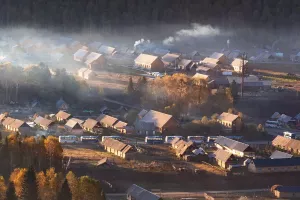Streams come in a variety of shapes, some majestic, others soft and graceful. Faced with its different forms, it is natural to use different shooting techniques to express different visual effects. After all, water is invisible, and how to freeze invisible water in an instant picture absolutely requires skill. So in the shooting of living water such as streams and waterfalls, what other photography techniques can highlight the effect of water flow? Let's learn together.
Composition is important
The composition of photography determines the quality of a work. When shooting a stream with gentle water flow, because the watershed is straight, standing on the stones on both sides of the stream and framing the stream diagonally along the photo is the best way to shoot. This can not only capture more water flow scenes, but also enrich the picture structure, combine the water flow with the stream, and make the gentle stream appear more abundant. However, if you encounter a winding river, you can choose a vertical composition, which can reflect the characteristics of the water flowing forward. Combined with slow-door photography, the water flow looks like smoke and fog, like a fairyland.
Choice of weather
Photos taken in rainy weather are often more depressing and dim, and the texture, impact and layers of the water flow are not easy to show. It is best to shoot in sunny weather, after all, the meaning of flowing water is generally full of vitality and spring. When the sun shines through the shade of the tree, the Tyndall phenomenon formed and the continuous flowing water combine together, which will make the whole picture warm and quiet.
Make good use of the foreground to capture the characteristic water flow curve
When we stand on the shore to photograph the stream, we often compose the picture in a depression angle. We can look for the leaves as the foreground, and observe the curve changes of the water flow, and shoot a simple but flowing work. If you are shooting from a low angle in the river, you can also look for stones and fallen leaves as the foreground, and let the flowing water cascade down, which will also make the work more layered.
Wide-angle lens is easy to capture momentum
Even a shallow stream with little water volume can be photographed with a wide-angle lens and a low-angle tripod, and a slow shutter speed to capture the details of the flowing water patterns of the stream can produce a magnificent work.
Note the flow of water
It would be too monotonous to just shoot the stream. So elements like lush trees can be consciously added to the foreground. In this composition comparison, the effect of water flow is more prominent, making the elements of the photo balanced and full of layering, making people feel relaxed and happy.
Transparency
Shooting clear streams can make people feel the transparency of the river, which is also a common technique for shooting stream waterfalls. If you encounter a shallower stream, you can fully present the feeling under the riverbed. If there is a special arrangement of stones, they will be clearly visible in the picture; if you encounter a deep stream, when the water quality is very clean, in addition to the expressive power given by the sense of transparency, you may also accidentally capture underwater creatures, adding to the The richness of photos.


